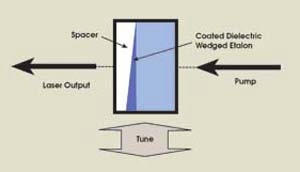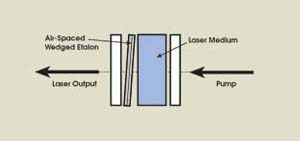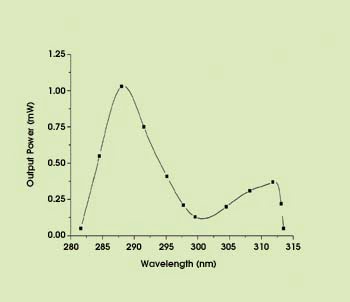
Wedged Etalon Simplifies Wavelength Tuning of Miniature Laser
Fully monolithic design for tunable microlasers is envisioned.
Breck Hitz
Solid-state microchip lasers, in which all the resonator elements — gain medium, resonator mirrors and, sometimes, Q-switch and/or frequency doubler — are bonded together in a monolithic block, have proved to be robust and commercially successful. But wavelength-tuning these lasers is challenging because conventional techniques, such as birefringent filters or other dispersive elements, require mechanical movements that are not possible in a monolithic device.
Now researchers at Macquarie University in Sydney, Australia, have demonstrated a method for tuning such lasers that requires only a simple sideways translation of the entire microchip relative to the pump light. The concept is to include a wedged etalon in the monolithic laser and to tune the laser’s wavelength by translating the entire laser transverse to the pump beam (Figure 1).

Figure 1. Researchers proposed integrating a wedged etalon into a monolithic laser and pumping it with a relatively narrow pump beam. Then, by translating the monolithic block perpendicular to the pump beam, they could change the wavelength transmitted by the etalon and, hence, the laser’s output wavelength.
A wedged etalon — an etalon with a wedge-shaped gap between the two reflecting surfaces — is different in several ways from a conventional (parallel plate) Fabry-Perot etalon, and the investigators examined these differences to ensure that none would seriously impede the laser’s operation.
First, because the plates are not parallel, the peak transmission is less than 100 percent. For the small wedge angle required here, the researchers calculated that this effect was negligible.
Second, there is a walk-off between the incident beams and the reflected beams resulting from the etalon’s wedge. But, again, for the small wedge here, the investigators concluded that this walk-off could be neglected. The most significant effect, they decided, is the variation in the etalon’s transmission across the intracavity beam’s diameter. Because the etalon’s spacing varies with position, the wings of the beam will experience a nonnegligible loss, depending on the wedge angle, beam width and reflectivity of the etalon mirrors. But, the scientists calculated, if these parameters are chosen appropriately, the loss would not preclude successful operation.

Figure 2. In a proof of principle, the researchers used the wedged-etalon technique to tune the wavelength of a miniature Ce:LiCAF laser.
As a proof of principle, they tuned the wavelength of a miniature Ce:LiCAF laser (Figure 2). The laser was not monolithic, but the researchers believed that applying the technique to one that was monolithic would be straightforward. Ce:LiCAF, when pumped at 266 nm, emits ultraviolet radiation between 282 and 314 nm. They obtained the pump light by doubling the output of a 532-nm Nd:YVO4 laser from Alphalas GmbH in Göttingen, Germany, in a ß-barium borate crystal, to obtain 12-μJ, 0.8-ns pulses of 266-nm pump light at a 1-kHz repetition rate.

Figure 3. By translating the laser in Figure 2 perpendicular to the pump beam, the researchers tuned its output from 282 to 314 nm. The linewidth was ~1 nm across the whole tuning range.
Their Ce:LiCAF resonator was 5 mm long, with two flat mirrors. The ~2.5-mm-diameter etalon reflectors had reflectivities of 70 percent (the back surfaces were antireflection-coated), and wedged with a spacing that varied from 1.1 to 1.3 μm across the diameter. By focusing the pump pulses to a 60-μm spot in the Ce:LiCAF crystal and translating the entire laser across the pump beam, the investigators observed an output tunable across the full 32-nm spectral range (Figure 3).
Optics Letters, Aug.1, 2006, pp. 2296-2298.
Published: September 2006